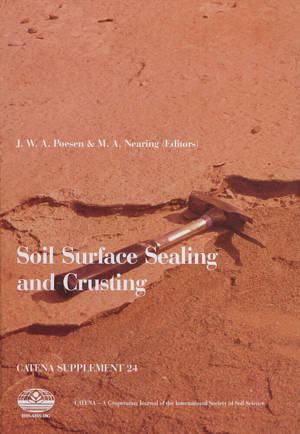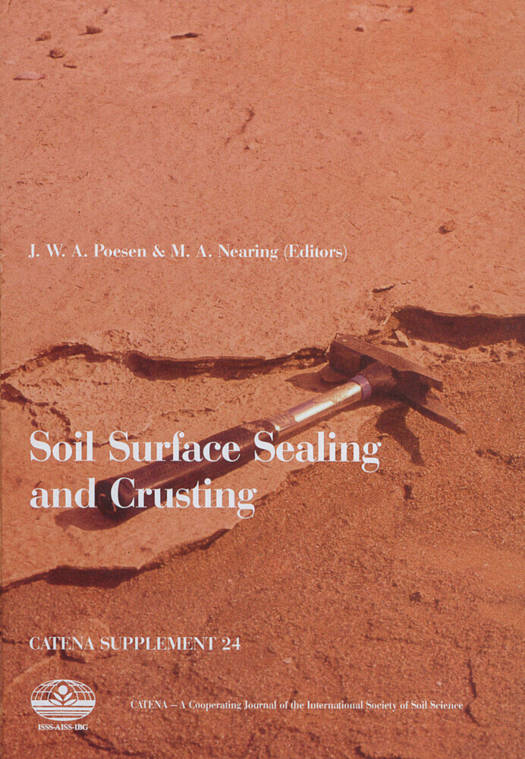
- Retrait gratuit dans votre magasin Club
- 7.000.000 titres dans notre catalogue
- Payer en toute sécurité
- Toujours un magasin près de chez vous
- Retrait gratuit dans votre magasin Club
- 7.000.0000 titres dans notre catalogue
- Payer en toute sécurité
- Toujours un magasin près de chez vous
Soil Surface Sealing and Crusting
Selected papers of the International Symposium on Soil Crusting, Chemical and Physical Processes, May 30-June 1, 1991, Athens, Georgia, USA
69,95 €
+ 139 points
Description
The boundary between soil and atmosphere is an important and active place. It controls to a large extent the flux of nutrients, water, gasses, and heat to and from the underlying soil and so it has a direct and dramatic influence on the conditions of the soil below the interface, the microbes, animals, and plants that live in the soil, and the amount of surface runoff generated from excess rainfall. The upper few millimeters of soil is the gateway to the soil below, and thus it has a direct and dramatic influence on the world around us. While the characteristics of the thin layer at the soil surface are important, they are also very much different from those of the soil underneath. Enormous amounts of energy and very high transient forces are imparted to the soil surface by impacting raindrops which break down aggregates, dislodge soil particles, and compress the upper few millimeters of soil. The physical disruption is aided by chemical processes, including dispersion, which further act to break down soil aggregates and greatly alter the surface characteristics of the soil. The resulting dense surface layer of soil is referred to generally as a surface seal. When the seal dries other physical and chemical factors cause a crust to form, which continues to have a dominating influence on gas, vapor, and heat exchange between soil and atmosphere, as well as an effect on seedling emergence. While soil surface sealing and crusting are certainly functions of local soil properties and climate, the processes are recognized and studied worldwide. At the International Symposium on Soil Crusting: Chemical and Physical Processes , which was held May 30 - June 1, 1991 at the University of Georgia, Athens, Georgia, USA, 37 papers/posters were presented by representatives from every continent. This CATENA SUPPLEMENT includes selected papers from the symposium. The first 4 studies reported here focus on quantifying changes in runoff and erosion amounts as a function of soil surface changes. Le Bissonnais & Bruand studied sealing and crusting on field plots under natural rainfall in Western Europe, and in particular they investigated seasonal differences. Nishimura & Nakano investigated sealing using a rainfall simulator and laboratory soil pans packed with an Andosol from Japan. Both of these studies also included a micromorphological study of the soil surface layer using scanning electron microscopy. Luk &; Cai performed a field study of the sealing and crusting characteristics of a loessial soil from North China, and specifically addressed the issues of how slope gradient and antecedent crusting influenced runoff and soil loss during a storm. Chiang, Radcliffe &; Miller studied the sealing of four soils from the southeastern and mid-western parts of the United States. Particularly interesting was the observation that even these soils, which had relatively high sand contents, experienced reductions in hydraulic conductivity due to surface sealing. The following three papers investigated the effects of dispersion on sealing, structural stability, and infiltration. So h Cook studied the relationships between soil structural stability and hydraulic conductivity using several clay soils from Australia. Rengasamy, Naidu, Chan &: Chartres related results from a modulus of rupture test to exchangeable sodium percentage for several Australian soils. Norton, Shainberg & Bradford showed a reduction in soil dispersion and sealing resulting from application of gypsum to three soils from the eastern United States. Thus they introduce a potential control mechanism for surface sealing problems. The study of Auerswald and that of Zhang &; Miller were designed to delineate the effects of moisture content on soil stability and erosion. Both studies showed that a decrease in soil moisture prior to rain produced a less stable surface and more soil loss for the same amount and intensity of rain. Lehrsch, Sojka, Carter & Jolley
Spécifications
Parties prenantes
- Editeur:
Contenu
- Nombre de pages :
- 139
- Langue:
- Anglais
- Collection :
- Tome:
- n° 24
Caractéristiques
- EAN:
- 9783510653652
- Format:
- Livre relié
- Dimensions :
- 170 mm x 240 mm
- Poids :
- 420 g

Les avis
Nous publions uniquement les avis qui respectent les conditions requises. Consultez nos conditions pour les avis.





